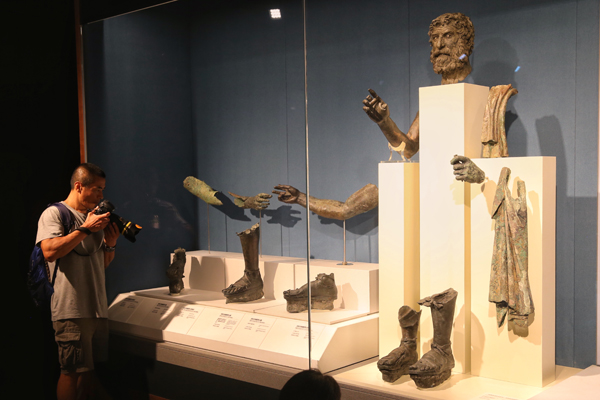Bronze sage


"The unkempt appearance recalls images of a Cynic philosopher," the curator says. "The work has recognizable elements of the early baroque."
But the exact identity of the man remains somewhat controversial to this day. Consequently, the statue is currently referred to as the "Antikythera philosopher".
Archaeologists also discovered components from at least three daybeds, some of which have made their way to Beijing for the exhibition. Similar items frequently appear in marble reliefs from ancient Roman times, but tangible physical evidence of their existence like these are rare discoveries.
"This daybed was surely a part of the most valuable cargo on the ship," the curator says. "Greek works of art played a significant role in the luxurious adornment of Roman architecture."
Perhaps, the situation is just like the preface of this exhibition has it: "A shipwreck means misery in terms of the cost of lives, but it also creates a time capsule that seals history."
After lying soaked in salty waters for 2,000 years, many of the exhibits were heavily eroded and had been torn apart. But Bo Haikun, the Chinese exhibition designer for the project, doesn't consider this as an obstacle to giving visitors an insight into classic Hellenic aesthetics.
"You don't just gain a sense of beauty from well-preserved and exquisite articles," he says. "These exhibits may be broken, but we can still feel the charm of their fine art from the details."
For example, a fragment of a boxers' left arm from a bronze statue is vivid enough to reveal a fierce fighting scene from an arena, especially through the thongs worn on his hands. And for an eroded set of marble statues depicting the Homeric heroes, Odysseus' and Achilles' mottled faces don't fail to reflect their spirit and legend.
Bo chose blue as the theme color for the exhibition hall, while exhibits were placed on white platforms to represent the sand at the bottom of sea. To create a sense of vicissitude and indicate the difficulty of the voyage, he assembled marble fragments from the art pieces and the sailors' everyday articles to create a montage.
"An amazing amount of knowledge is hidden in these artifacts. The exhibition will help to explain their stories to visitors," Bo adds.
The Antikythera mechanism, a set of 82 components from a bronze analog computer, was found in the shipwreck. Lagogianni-Georgakarakos says it represents a major scientific achievement for the ancient Greeks.
The complex assembly of gear wheels created an output in three main dials, and the mechanical parts were protected by a wooden-framed case.
"The similar technology only reappeared in Europe during the 14th century," she says.
However, archaeologists finally decided not to allow this precious artifact to be removed from the National Archaeological Museum of Athens for the Beijing exhibition because of its fragile condition.
Despite this, the exhibits in Beijing include several replicas of the computer, based on academic research over the last century and detailed illustrations of its historical background.
It was also a pity that a bronze statue known as the "youth of Antikythera", probably the most complete artifact from the wreck, could not be given approval to be flown to Beijing following an X-ray check.
"So, I welcome Chinese visitors to join our exhibition in Athens to see them," the Greek curator says.
To bring The Antikythera Shipwreck to the Palace Museum, 10 Greek archaeologists, two sculptors, one architect, and 16 conservators spent eight months preparing.
And this project is just one example of the collaboration between the Palace Museum and its Greek counterpart.
Also on Sept 14, an exhibition of items from the Palace Museum opened at the Acropolis Museum in Athens as part of the growing cultural exchanges between the two countries.
A Sino-Greek laser technology laboratory opened in 2016 at the Palace Museum focusing on the conservation of stone cultural relics.
Contact the writer at wangkaihao@chinadaily.com.cn
If you go
The Antikythera Shipwreck
Through Dec 16 (closed on Mondays)
Open hours: 8:30 am to 5 pm (no entry after 4:10 pm) Gate of Divine Prowess (Shenwumen) Gallery, the Palace Museum, 4 Jingshan Qianjie, Dongcheng district, Beijing
More information on official website of the museum: en.dpm.org.cn





































